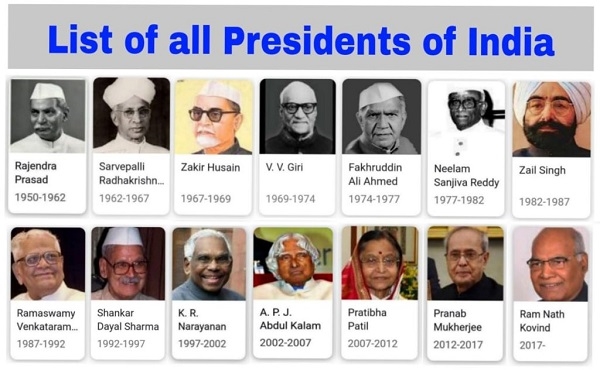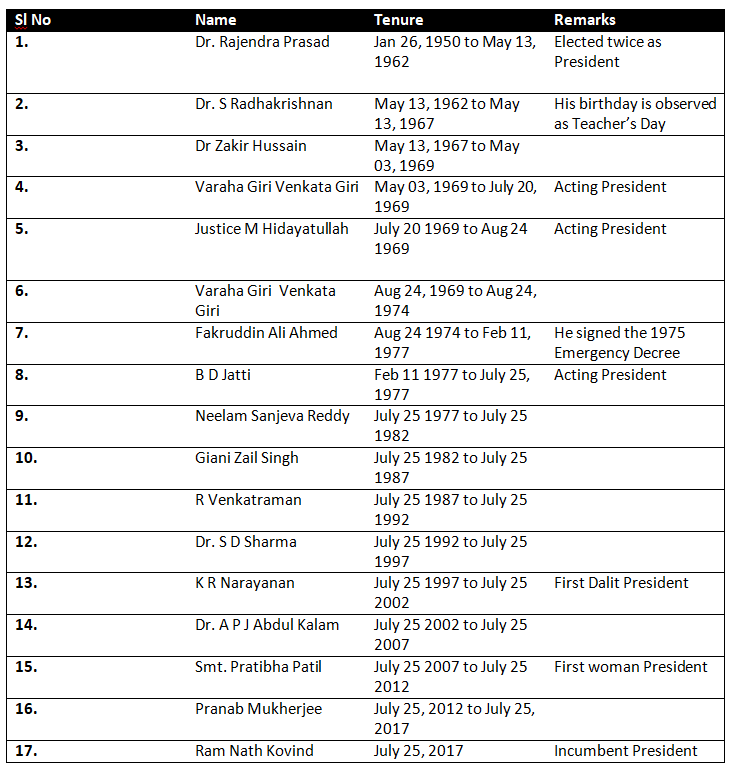Presidents of India: From Rajendra Prasad to Ram Nath Kovind
Total Views |
India attained independence on August 15, 1947, though in a truncated manner. It was not declared as Republic then. So we had a Governor General in Chakravarty Raj Gopalachari. Rajaji or CR as he was known in the public life, the last Governor General of India was a freedom fighter, writer, lawyer, historian and a statesman. Hailed as India’s Conscious Keeper’ Rajaji held the office of the Governor-General till 1950 when India became a Republic. He was also the main advocate of ‘minimum government maximum governance’ concept being introduced and implemented by the present government under Narendra Modi when he first became the Prime Minister in 2014.
India became a Republic in 1950 as the Constitution was adopted and Rajendra Prasad was elected as First President of the Republic in that year. The President who is also called as the ‘First Citizen of the Country’ is the head of the state and Supreme Commander of the Armed forces. However, as we have adopted the Westminster model of democracy, the post of the President has remained mostly ornamental and the executive powers are vested in the Prime Minister. Rajendra Prasad was the first to get elected twice to the post of the President.
Rajendra Prasad was also the first President to have attended the inauguration of renovated Somnath Temple in Gujarat ignoring the stern opposition from Prime Minister Jawaharlal Nehru. Nehru was of the view that Prasad represented a secular government and need not attend the ceremony at Somnath which according to Nehru was against the principle of secularism. Rajendra Prasad ignored this ‘warning’ of the Prime Minister and attended the ceremony.

India has seen 14 great personalities adoring the office of the President since 1950. Amongst them the highest percentage (41.2%) candidates belonged to the Congress Party which ruled the country for over 60 years. There were three Acting Presidents also who remained in the office as a stop-gap arrangement. Varaha Giri Venkata Giri was the first Acting President who succeeded Dr. Zakir Hussain who died in office. Giri was later elected as President a few months later. Thus, he became the first person to have held the office both as Acting and Elected President.
Seven out of the list were associated with political party and six out of them were active members of the Congress Party. Neelam Sanjeeva Reddy who was ditched by the then Prime Minister Indira Gandhi contested the election as a Janata Party candidate in 1977.Giani Zail Singh, R. Venkatraman, Dr. Shankar Dayal Sharma, K R Narayanan, Pranab Mukherjee and Pratibha Patil were the active members of the Congress party and held various positions in the respective Congress governments.
Dr. Zakir Hussain and Fakruddin Ali Ahmed died in office. The later signed the 1975 infamous emergency decree in the night even before the parliament approved it. This gave the then Prime Minister Indira Gandhi’s government unlimited blanket powers to put anybody behind the bars for voicing opposition or criticism against the government.
Following the death of Dr. Zakir Hussain in office, V V Giri was made the Acting President. When Giri resigned to contest the Presidential election as a Congress party candidate, Justice M. Hidayatullah succeeded him as the Acting President. Similarly, when Fakruddin Ali Ahmed died in office he was succeeded by Basappa Danappa Jatti as acting President in 1977.
When President Giri was in the office, the Bharatiya Mazdoor Sangh (BMS) submitted him the “Charter of the Workers” to him. The charter was prepared under the guidance of BMS Founder Dattopant Thengdi. Giri, impressed by the Charter, described it as “Shrama Veda”. This was the highest tribute and recognition offered by the President of India to BMS.

Pratibha Devisingh Patil has the distinction of becoming the first woman president of the Republic in 2012. She was supported by the Shiv Sena on the issue of ‘Marathi Manoos’, politically forgetting their commitment to ‘Saffron or Hindutva’ ideology.
Pranab Mukherjee, the senior Congress leader and former finance minister succeeded Pratibha patil as 13th President of the Republic in 2017. He administered the oath of office and secrecy to first full majority government of Bharatiya Janata Party-led NDA government under Prime Minister Narendra Modi. Both Modi and Mukherjee had very good relations and regarded each other with due respect. This was seen as no less than a miracle as both belonged to different political ideologies.
Mukherjee will also be remembered as the first president to have visited and shared the RSS platform and expressed his views about the founder of the RSS when he visited his ancestral home in Nagpur. When Atal Bihari Vajpayee was elected Prime Minister second time, the then President K R Narayanan administered him oath of the office with reluctance as he was opposed to the Hindutva ideology of the BJP. Later when he was succeeded by Dr. A P J Abdul Kalam, Vajpayee government conducted atomic tests in Pokharan defying all satellite surveillance of the US and other nations. That was the greatest achievement of India in atomic field after Pokharan 1 test conducted by Indira Gandhi in 1974.
.
.

